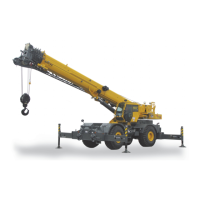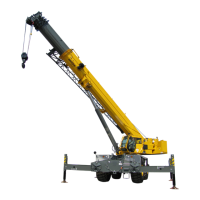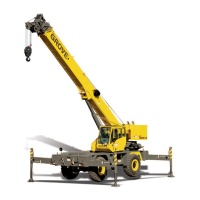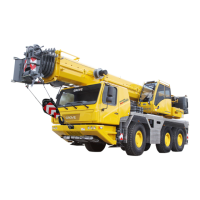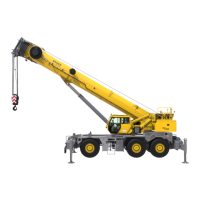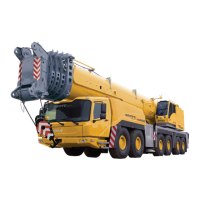OPERATING CONTROLS AND PROCEDURES RT765E-2 OPERATOR MANUAL
3-20 Published 4-09-2021, Control # 364-11
position. The backup alarm is installed in the rear outrigger
box behind the grill plate.
Emergency Exit
The windshield is considered the Emergency Exit. In an
emergency, push out on the windshield and escape through
the opening.
OPERATING PROCEDURES
Pre-Starting Checks
A complete walk-around visual inspection of the crane
should always be made with special attention to structural
damage, loose equipment, leaks, or other conditions that
would require immediate correction for safety of operation.
Refer to the Inspection and Lubrication Service Log. One
copy of the Inspection and Lubrication Service Log is
provided in the original package of manuals shipped with the
crane. Additional copies are available through the Grove
distributor network.
Check the following items to make sure that the crane is
prepared for starting the day’s work.
Fuel Supply
Check the fuel level and make sure the cap is on tight.
Engine Oil
Check the oil level in the crankcase and fill to the FULL mark
on the dipstick. Do not overfill.
Engine Coolant
Check the coolant level in the radiator surge tank sight
gauge and fill to the proper level. Do not overfill. Check to
make sure the radiator and reservoir caps are secure.
Batteries
Check that the battery cables and clamps are tight and not
corroded.
Signal and Running Lights
Check all signal and running lights for proper operation.
Replace burned out lamps with those of the same number or
equivalent.
Foot and Parking Brakes
Check the foot and parking brakes for proper operation.
Daily Lubrication
Make certain that all components requiring daily lubrication
have been serviced. (Refer to Section 5, Lubrication.)
Hydraulic Reservoir and Filter
Check hydraulic fluid quantity level and filter condition
indicator. Check breather for cleanliness and ensure it is
secure.
Tires
Check for severe cuts, foreign objects embedded in treads,
and for correct inflation pressures. A tire inflation chart,
providing the correct air pressures, is located in the Load
Chart Book in the crane cab.
Wire Rope
Inspect wire rope in accordance with applicable Federal
Regulations.
Inspect sheaves, guards, guides, drums, flanges, and any
other surfaces that may come in contact with the rope for any
condition that could cause possible damage to the rope.
Wire rope replacement should be determined by the
following information excerpted from a National Consensus
Standard as referenced by Federal Government Agencies
and as recommended by Grove. All wire rope will eventually
deteriorate to a point where it is no longer usable. Wire rope
shall be taken out of service when any of the following
conditions exist:
Kinking, crushing, birdcaging, or any other damage resulting
in distortion of the rope structure.
• Evidence of any heat damage from any cause.
• Reductions from nominal diameter of more than 5%.
• In running ropes, six randomly distributed broken wires
in one lay or three broken wires in one strand in one lay.
• In standing ropes, more than two broken wires in one lay
in sections beyond end connections or more than one
broken wire at an end connection.
• In rotation resistant rope, two randomly distributed
broken wires in six rope diameters or four randomly
distributed broken wires in 30 rope diameters.
• Severe corrosion as evidenced by pitting.
• Grove recommends that for cable extended booms, a
single damaged wire rope assembly shall require
replacement of the entire set of extension cables.
• Grove recommends for cable extended booms, that
boom extension cables be replaced every seven (7)
years.
Hook Block
Visually inspect for nicks, gouges, cracks, and evidence of
any other damage. Replace any hook that contains cracks or
shows evidence of excessive deformation of the hook
opening, including twist. Be sure the safety latch is free and
aligned.

